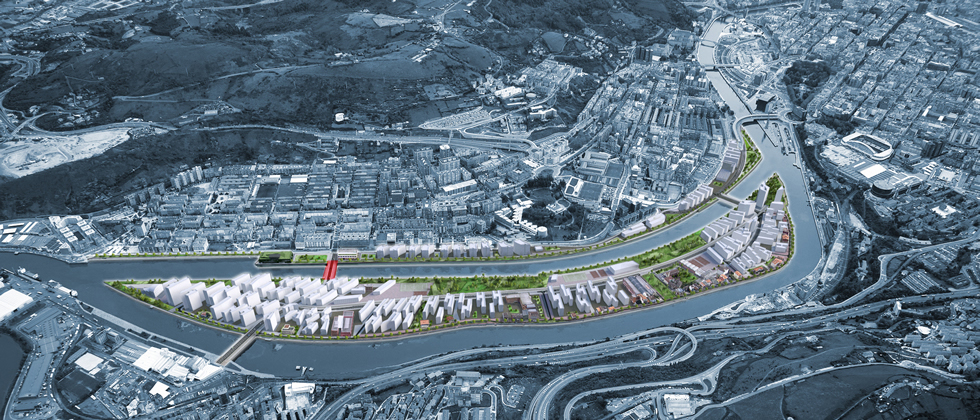OPERATIONS

SAN IGNACIO BRIDGE
The bridge that will connect the San Ignacio quarter to the Zorrotzaurre Island over the Deusto canal, and as a continuation of the Islas Baleares Street, was designed by the civil engineers, Enrique Elkoroberezibar and Sergio Saiz of the firm, LKS Ingeniería S.Coop.
The new bridge will cover 75 metres without intermediate support and will be 28 metres wide with the following breakdown: 6.7 metres for two traffic lanes, 7.0 metres for 2 bus lanes, 2.5 metres for a two-way cycle path and 8.8 metres for two pedestrian pavements of 4.4 metres each.
The estimated investment is 8 million euros, excluding VAT and will be financed by the Basque Government. Works are expected to last 17 months.
SCHEME AND STRUCTURAL CONCEPT
The main conditioning factors that define the conceptual scheme of the bridge are:
- A span of 75 metres without intermediate supports over the channel
- The main material was to be steel as a reference to the steelmaking tradition of Bilbao. Although this is a common usage in Bilbao, it continues to be valid.
- The bridge was to be elegant and fluid in form, not suppose a visual barrier and in which a sober nature and the constructive technology were the objective.
The main support for the projected solution were two symmetrical arches that start from the channel under the bridge and gently rise above it to a height of 3 metres in the middle. Two longitudinal supports hang the load of the platform from the arches by means of hangers every 1.5 metres. This measure gives the pattern for the rest of the elements that go to make it.
The scheme is completed with three families of transversal elements that materialise the deck and transfer the load to longitudinal ribs and to a family of longitudinal beams placed between the arches to control the dynamic behaviour of the platform.
On the exterior of the arches there are two families of ribs (up-river and down-river) with a variable edge and refined form with an interaxis between them also of 1.5 metres. A structural tramex is placed over them to make up the deck and over them the pavement of synthetic wood. The transversal section is a double T with closed cells in the lower wing.
The arches are filled with concrete along their full length. In the struts, the section is a variable width rectangle (2.79 to 1 metre) and constant edge of 0.7 metres. In the central part, the section is a triangular metallic V-shaped form with an edge of 0.7 metres and a width of 1 metre.
The longitudinal ribs are of rectangular metallic section, 1 metre wide and 1.16 metres on the edge. These ribs work, together with the slab of the deck, as the traction cord of the arch.
To complete the platform in the area between the arches the slab of the deck is formed from corrugated sheet and concrete in situ.
The railing is formed by security glass without a frame and finished with an undulating handrail that invites one to lean on it and contemplate the river. The lack of a frame gives a sense of lightness and transparency that increases the perception of the bridge as a light object that rests on solid supports of concrete.
ILLUMINATION
All the lamps used, both for functional and ornamental illumination are LED technology.
The functional illumination is by two 12 metre high columns (one at each end) each with three lamps directed towards the platform.
The ornamental illumination is by lamps built into the pavement just under the arches in the space between the hangers. The lamps illuminate the arch from below. The struts, which are the continuity of the arches below the deck are also illuminated with lamps located on the ribs just below the platform.
MATERIALS
The structure is projected in steel and concrete. The reinforced concrete is the main material of the ribs and carbon steel (finished in white) for the deck.
The pedestrian pavements are of synthetic wood (made from wood and resin), while the road surface is a bitumen mix. The cycle path is made from a reddish micro-agglomerate.
URBAN INTEGRATION
At the north end of Zorrotzaurre island there is an important connections hub, which allows the future central avenue of the island to connect to Punta Zorrotza on one side and with San Ignacio on the other via this bridge. Within this scheme, the bridge forms part of the urban environment and integrates, fulfilling its function in a simple manner.
The arches allow a pure aesthetic expression, which seeks no protagonism. The purity of its forms responds to the structural and functional requirements, justifying itself without empty attempts at significance.
The slenderness of the arches and the glass frameless panels create a reduced visual impact in a river that already has plenty of outstanding items.
Within the bridge, a quick look from any point allows us to understand the form and the function and to perceive the surroundings without interference.
On the right bank, the stirrup of the bridge is integrated with the existing wall and buttresses. The coping of the wall finishing is adapted to the new geometry of the stirrup creating a formal unity between the two structures.
On the left bank between the stirrup and the new containing wall the coping is mounted vertically as a joint.
COMPATIBILITY WITH THE AVENUE SYSTEM OF THE RIVER
The bridge is projected to allow the maximum flow of the river, compatible with a 500 year event and which is set at the +4.47 metre level, and to facilitate drainage, it will have at least one metre of lower guard over a length of 40 metres of width centred on the canal.


